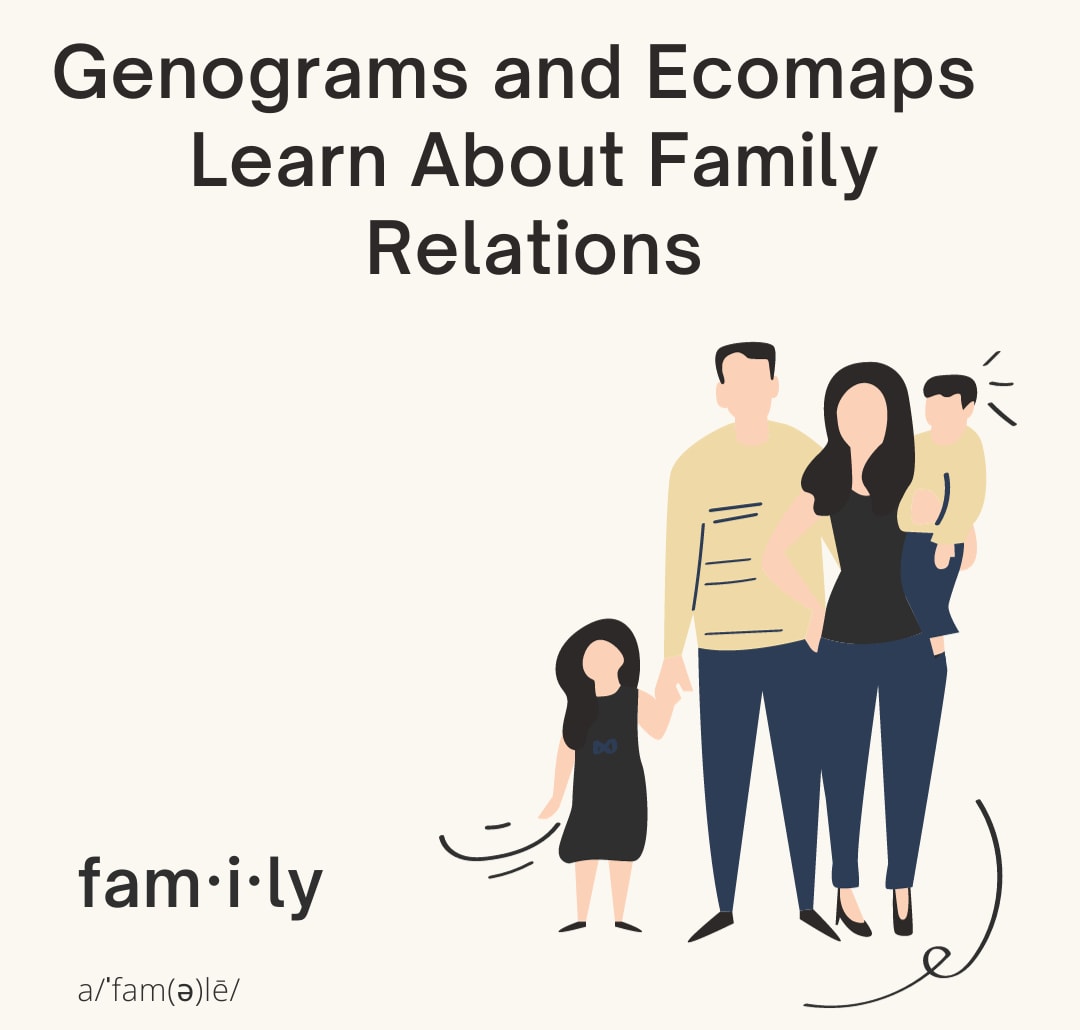Ecomaps and Genograms visually illustrate familial relationships, social interactions, and genealogy information. Combine them effectively to learn surprising facts about yourself.

Complex, functional, or dysfunctional, family relations leave a lasting impact on a person’s conscious and subconscious choices. Family dynamics and patterns of interactions have trickled down from generations and have a genealogy history, making them significant for our routine emotional and social dealings.
Ecomaps and genograms are two visual alternatives to understanding and analyzing familial connections. These diagrams encapsulate emotional, social, behavioral, and medical facts about an individual. When combined, they can effectively aid healthcare and social work professionals in making a decisive diagnosis.
Want to know more about how they are implemented? Dive right in.
In this article
Part I. Understanding Ecomaps
Developed for social research by Ann Hartman in the 1970s, ecomaps visually illustrate one person’s connections with families, societies, and communities. Hartman used ecomaps to visualize the environment in which a person lives and interacts. Typically, these diagrams are used by social workers, medical personnel, and counselors to get a deeper insight into their clients’ lives and analyze their needs.
Benefits
- Track the client’s social networks.
- Answer the social worker's questions.
- Identify changes in the client’s relationships from the past.
- Start the medical and social discussions with clients.
Symbols
The solar system inspired Ann Hartman’s first ecomap design. The sun, shown through a big circle in the center, represents the person, with small planets revolving around it as people and groups present in the person’s life. Between these circles and squares are connecting symbols. These symbols represent the strength of the relationship.
| Line | Relationship |
| Thick Line | A strong connection |
| Curved Line/ Broken Line | A negative and stressed connection (often red in color) |
| Small Arrows Along the Line | A resource and interest-based connection (the pointed end of the line represents the direction toward something) |
| Line with Cross Through Them | A stressed connection |
Ecomap Design
Making an ecomap design is straightforward, and you can start from a white paper. However, digital diagram software is better, with readymade templates and advanced formatting tools. Here is how designing an ecomap goes.
- Draw a large circle in the center and mention all the family members. Use squares for males and circles for females.
- Draw smaller circles to represent extended family members and social contacts. They can also be social institutions like churches, schools, work, government institutions, etc.
- Identify their relationships. Use the right lines to connect the central circle with outer entities.
Part II. Exploring Genograms
First developed by two clinical psychologists, Monica McGoldrick and Randy Gerson, genograms are family trees but more advanced. A typical genogram goes back to two generations to visualize your intricate family links and take detailed factors (behavioral, psychological, emotional, etc.) into consideration.
These diagrams are used by healthcare professionals, therapists, counselors, researchers, and social workers to trace a person's genealogy.
Benefits
- It reveals the medical history of your family.
- It explores the emotional connection between immediate and extended family members.
- It gives insight into deep family ties.
- It helps healthcare and social work professionals make thorough assessments.
Symbols
Genograms use various symbols to communicate relationships between family members, including family-specific, medical, emotional, and psychological signs. You need to know the basic genogram symbols mentioned below for an entry-level genogram.
| Symbol | Meaning |
| Circle | Female (child or adult) |
| Square | Male (child or adult) |
| Triangle | Pregnancy |
| A triangle with a cross | Miscarriage |
| A triangle with a cross and a dividing line | Abortion |
| Diamond | Pet |
| Cross | Death |
Relationship Symbols
| Symbol | Meaning |
| Straight line | Marriage or blood relationship |
| Broken line | Non-marital relationship |
| Line with a diagonal | Married couple separation (children custody is with one parent on one side of the diagonal) |
| A broken line with a diagonal | Separated couple |
| Line with two diagonals | Divorce |
Genogram Design
- Before you dive right into plotting genograms on paper or digital canvas, let us look at some rules.
- The male is on the left.
- The female is on the right.
- The oldest child is on the left.
- The youngest child is on the right.
Now, proceed further and start drawing.
- Decide why you are making a genogram and choose appropriate symbols.
- Make a decision about the generations to include.
- Gather information by talking to family members or filling out questionnaires.
- Choose an online genogram to get started, as they are easy.
Part III. Comparing Ecomaps and Genograms
Now that we have established a basic understanding of ecomaps and genograms, let us proceed and see how they are connected.
Similarities
Ecomaps and genograms have a complementary nature, as both represent family relationships. A genogram is a starting point of an ecomap because it helps professionals build an understanding of a person’s medical, emotional, and psychological state. Social workers and counselors can use basic family relations from genograms to analyze their interactions in societies through ecomaps.
Differences
Information Structure
The most obvious difference between ecomaps and genograms is how the information is displayed. Genograms are intricately structured and show a detailed description of a person’s family. These maps are inclusive of behavioral, social, medical, and emotional factors.
However, ecomaps allow you to understand a man’s personality based on his day-to-day social interactions. They purely focus on social networks (like family, neighbors, work colleagues, school staff, etc.).
Use Cases
Both ecomaps and genograms are used in social work, but their applications differ. For instance, healthcare professionals or counselors use genograms to learn about the person’s family history with drugs and mental health for a better diagnosis.
In contrast, ecomaps are primarily used by nurses. They track the supporting care network for parents to manage their health using the right resources among the person’s connections after discharge.
Conclusion
Understanding interactive patterns of yourself with families, friends, and colleagues is essential for maintaining a healthy emotional and physical state. Professionals have been combining ecomaps and genograms to diagnose people and help them achieve well-being.
The good part about these diagrams is that any layperson can make them. All you need is a clear purpose and a proper planning and execution strategy. So, if you feel like plotting these diagrams and analyzing yourself can bring opportunities to improve your well-being, give them a try. You may find some surprising facts about your genealogy or medical history. [没有发现file]




 below.
below.  below.
below.



